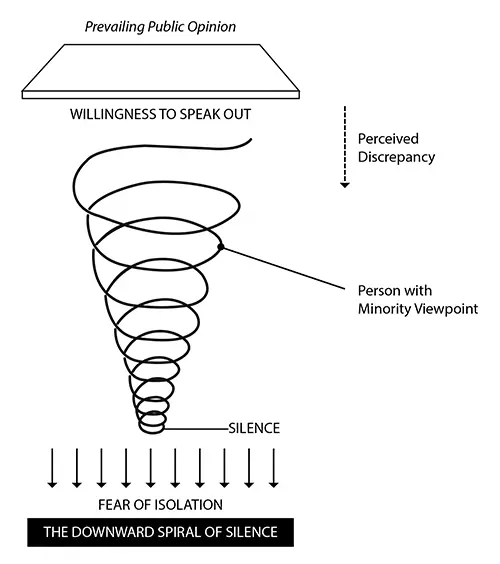Spiral of silence theory was first proposed by Elisabeth Noelle-Neumann in 1984. She was a German political scientist, President of “World Association for Public Opinion Research” and one of the founders of “Public Opinion Organization”.
As per her analysis, people’s political support to Germany was the main cause for Germany’s defeat in world war II. This inspired her to propose Spiral of Silence theory. It was made for both politics and mass communication.

The theory talks about the relationship between minority and majority of people and how they express themselves. It proves minority people keep silent on their views on any particular subject. For example, how Jews, who did not support the second world war, but stayed silent.
One of the main aspect of this theory is fear of isolation and exclusion of a group of people. This is seen in media, which is mostly democratic and run by the majority.
So, it advocates dominant ideas and the majority view. Thus, minority does not voice their opinion and has a tendency to remain silent.
Concepts in Spiral of Silence Theory
Spiral of silence theory is described in a diagram as a spiral with two ends. The top end of spiral is the view of majority which is wide. While, the lower end which consists of the shallowest part are the views of minority.
According to the assumptions of the theory, people through intuition or awareness know what the majority thinks. They do not talk out loud unless they know that their views conform to majority. If a person thinks that his/her views are closer to that of the majority, he/she express it more often and with more value.
On the other hand, people restrain themselves from telling it to others if they think the opinion of majority is changing. This might lead to change in their own opinion as well.
Assumptions of Spiral of Silence Theory
The major assumptions of the theory why minority do not speak up are:
- Every individual has a “quasi-statically organ” (sixth sense) that makes them know prevailing majority public opinion.
- Individuals have fear of isolation from a group of people. He/she could have divergent or negative opinions and might not support status quo.
- People have fear of reprisal or vengeance. This can cause more extreme isolation or exclusion.
Relation to Mass Media
Media shows what majority thinks to be true as true. It acts as a source to influence public opinion and measure its rate. Spiral of Silence Theory takes media as a reference. The theory explains its psychological influence on individual behavior conforming them to majority views.
Here, dominant opinions of mass media and interpersonal support work together to suppress general public opinions. These opinions are different than what most people think.

Features of Spiral of Silence Theory
- It is a dynamic process.
- Mass media influences spiral of silence phenomena.
- Marginalization is a tool for elimination of competition in political, social and organizational scenarios.
- People are afraid to speak out due to their fear of isolation.
- People can even withdraw their opinions to conform to group.
- A greater number of people can reject others who don’t conform to them.
- Minorities get less vocal space.
- It is used in both micro or macro levels.
- The degree of openness depends on the view of majority on the issues.
- The consequence can be as severe as war.
Examples of Spiral of Silence Theory
- In political elections, usually people are asked about their thoughts on candidates. They try to support the popular candidate confidently or do not give out their opinions. This explains the theory.
- In 1991, support for Gulf War from the people of U.S. was measured through survey. The results showed that most people were opposed to the war and were not supportive. Rather, media, which was supportive of the government and war, showed otherwise. People, who got information through media, were more supportive of war as they wanted to be in the majority.
This is spiral of silence. People who did not support the war were many, but did not speak up against it. They got the view that what media showed was the view of the majority. - When a new rule is set in any organization, most of the employees do not complain. The minority who want to protest also can’t do it due to the fear of isolation.
Criticisms of Spiral of Silence Theory
- Individual personality differences influences in people voicing their opinions or not. Shameless or over-confident people can speak anything they like even if they fall on the minority group.
- Other aspects like a person’s political inactiveness prevents spiral of silence to work, even if he is in minority.
- People’s fear to be isolated from their immediate small social circle, like their family and friends, is more pronounced.
- People will find other group of people who share similar opinions if they want.
- Culture also plays a great role in the behavior of people to speak against anything. Individualistic cultures promote freedom of speech, whereas collectivist cultures want conformation to groups.
[Related Reading: Communication Accommodation Theory]
